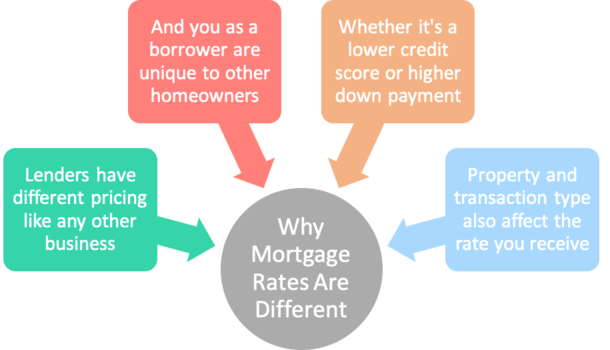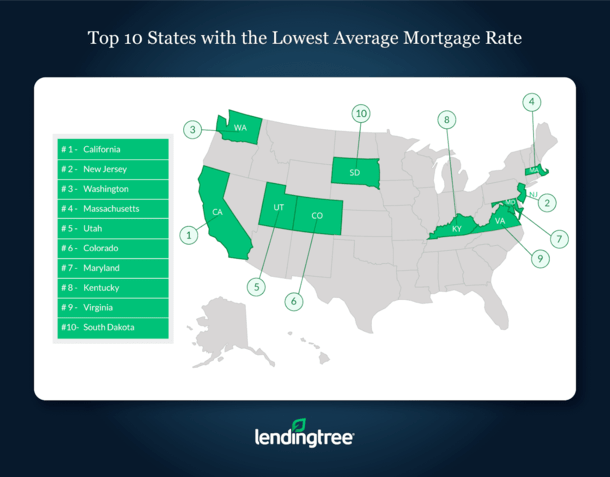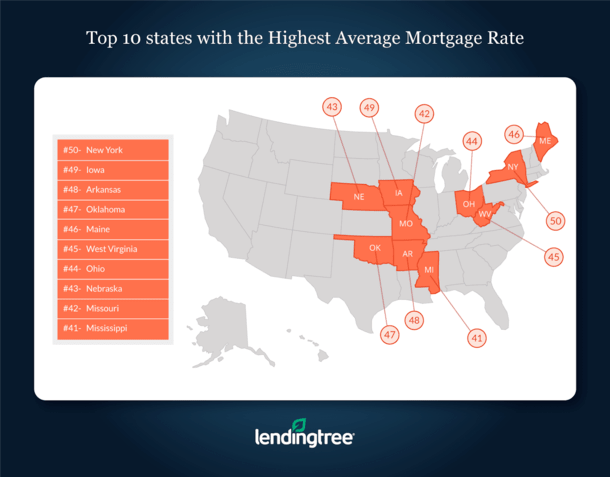Mortgage rate Q&A: “Why are mortgage rates different?”
Why is the sky blue? Why are clouds white? Why won’t your neighbor trim their tree branches?
These are all good questions, and ones that often puzzle even the most savvy of human beings.
First things first, take a look at how mortgage rates are determined to better understand how banks and mortgage lenders come up with interest rates to begin with.
From there, you’ll need to consider why mortgage rates are different for consumer A vs. consumer B, and from lender to lender.
No One Size Fits All for Mortgage Rates

- Mortgages are kind of like snowflakes in that no two are exactly the same (OK, not really)
- The subject property and the borrower will always have somewhat unique characteristics
- This means the risk on the underlying loan will vary and so too will the interest rate received
- Lenders also price their mortgages differently so even identical scenarios can result in variable pricing
Mortgages are complicated business, and there certainly isn’t a one-size-fits-all approach in this industry.
First off, there are thousands of different banks, lenders, and credit unions that offer home loans, some of them entirely unique and proprietary.
These companies compete with one another to offer the lowest rate and/or the best customer service.
The well-known names might offer higher rates in exchange for their perceived trust and familiarity.
Meanwhile, the smaller guys might offer rock-bottom rates to simply stay in contention with the big players.
A big advertising budget might mean a higher rate to cover those costs. While a discount lender might be able to pass along savings if they run ultra-lean.
Along with that, every loan scenario is different (just like a snowflake), and must be priced accordingly to factor in mortgage default risk (risk-based pricing).
Simply put, the higher the risk of default, the higher the mortgage rate. But that’s just the tip of the iceberg.
There also promotional rates, such as mortgage rates that end in .99%, and innovative marketing products like UWM’s Exact Rate that lets brokers offer strange rate combinations, including 2.541% or 2.873%.
So the possibilities truly are endless these days when it comes to different mortgage rates.
Mortgage Rates Vary Based on the Loan Criteria
- Mortgage lenders make a lot of assumptions when advertising rates
- Your particular loan scenario may be quite different than their hypothetical loan
- You have to take into account the many pricing adjustments applicable to your mortgage if it doesn’t fit inside that box
- These adjustments have the potential to greatly increase or decrease your interest rate
Mortgage rates don’t exist in a bubble – the parts affect the whole.
Banks and lenders start with a base interest rate (par rate) and then either raise it or lower it (rarely) based on the home loan’s criteria.
There are loan pricing adjustments for all types of stuff, including:
· Loan amount (conforming or jumbo)
· Documentation (full, stated, etc.)
· Credit score
· Occupancy (primary, vacation, investment)
· Loan Purpose (purchase or refinance)
· Debt-to-Income Ratio
· Property Type (single-family home, condo, multi-unit)
· Loan-to-value / Combined loan-to-value
The more you’ve “got going on,” the higher your mortgage rate will be. And vice versa.
In short, an individual purchasing a single-family home with a conforming loan amount, 20% down payment, and a 800 FICO score will likely qualify for the lowest mortgage rates available.
Conversely, the individual requesting cash out on a four-unit investment property with a 640 FICO score will be subject to a much higher rate, assuming they even qualify.
I’ve already covered a few related topics, including why mortgage rates rates are higher for condos and investment properties.
Mortgage rates also tend to be higher on jumbo loans and refinance transactions, especially those involving cash-out.
And again, rates will vary from lender to lender, even with the same attributes, so it’s a multi-layered situation.
Advertised Mortgage Rates Are Best Case Scenario
- Mortgage rates on TV and online are usually best-case scenario
- They are intended to be super attractive to lure you in and snag your business
- When the dust settles your interest rate might look nothing like what you saw advertised
- This is why it’s important to shop around and better understand how risky your particular loan is
You know those mortgage rates you see on TV or on the Internet?
Those assume you’ve got an owner-occupied single family home, a perfect credit score, a huge down payment, and a conforming loan amount.
Not to mention a newborn golden retriever with an unmatched pedigree.
Most people don’t have all those things, and as a result, they’ll see different mortgage rates. And by “different,” I basically mean higher.
How much higher depends on all the factors listed above. So take the advertised rates you see with a huge grain of salt.
Also, put in the time to shop your home loan with different lenders, and in the process, get to better understand your risk.
Find out what lenders are docking you for and take steps to fix those things if you want the lowest rates available.
Tip: Determine if you can structure your loan slightly differently to obtain better pricing. This might mean a higher down payment or a different loan program, such as FHA vs. conventional.
The Same Exact Mortgage Can Be Priced Differently with Two Lenders
Now let’s assume you and another borrower have the same exact loan scenario.
You’re both putting down 20% on a single-family home purchase you intend to occupy. You both have 800 FICO scores. You both want a 30-year fixed mortgage.
Heck, you’re both paying one discount point at closing to get a slightly lower interest rate. And for fun, even the lender fees are the same.
But somehow, one lender is charging an interest rate .50% higher than the other. How can that be?
Well, like any other business, it’s good old-fashioned marketing.
When you go to the grocery store, you might compare two similar products. They both seem to be the same, other than the packaging. Oh yeah, and the price.
A home loan can be no different. At the end of the day, you’re still getting a 30-year fixed mortgage with the same exact rate and closing costs.
The only difference might be the process and the customer service. But what’s more important, the process or the monthly payment for the next 30 years?
A recent analysis by the Consumer Financial Protection Bureau (CFPB) found that price dispersion for mortgages is often .50% of the APR.
So it wouldn’t be uncommon to see one lender advertising an APR of 6%, while another offers 6.5%. For the same exact loan.
In other words, lender choice matters an awful lot too, regardless of your loan scenario, loan type, FICO score, etc.
You might not be able to control your credit score or down payment, but you have the ability to shop around and get more than a single quote. And it can make a real difference!
Do Mortgage Rates Vary By State?
- Yes, they sure can! You might get a lower rate in California vs. Nebraska
- Depending on lender appetite for a certain geographic region
- Rates may vary from state to state, or even in certain counties
- Make sure the lender you use offers the best pricing for the state in which you reside
One last thing. I’ve been asked if mortgage rates can vary from state to state, and the answer is actually YES. In fact, they can even vary by county in some cases.
As you can see from the image below, some states tend to have lower average mortgage rates for one reason or another.

This list is from February 2019, when the average rate for the 30-year fixed was 4.84% nationwide, per LendingTree.
While no state offered an average rate below 4.74% or above 4.96% (pretty narrow range), there was some divergence by locality.
California led the nation with an average rate of 4.74%, followed closely by the 4.75% average seen in New Jersey and the 4.76% average found in both Washington and Massachusetts.
Nothing earth-shattering, but still different nonetheless.
But it might not be for any one reason, such as a higher default rate in state X or fewer natural disasters in state Y. Or more regulations in another state.
It could be more to do with the fact that lenders want to increase their business in a certain part of the country, and thus they’ll offer some sort of pricing special or incentive to drive rates down in say California.
So you might see a rate sheet that says .50% rebate state adjustment for loans in CA and FL, for example. This will give them a competitive advantage in those regions.
How about states where mortgage rates tend to be slightly higher, such as New York, Iowa, and Arkansas, which averaged 4.96%, 4.93%, and 4.92%, respectively?

It’s possible you might see a pricing adjustment of say .25% for one of these states that may drive the interest rate up somewhat.
In other words, rates can be priced both higher or lower depending on the state where the property is located.
Of course, if this results in unfavorable pricing you can just move on to a different lender that doesn’t charge more for the state in question.
All the more reason to shop around, compare mortgage rates online, and speak with a mortgage broker or two.
Once you’ve done that, check mortgage rates with your local bank or credit union as well.
Don’t be one of the many who obtain just one mortgage quote because you may wind up paying too much.
Read more: What mortgage rate can I expect?


